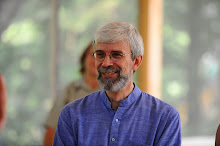What do you get when you attempt to found a community on spiritual principles of love, compassion, and harmony between nations and peoples? Answer: Auroville. Further, if you’re interested in a place that caters to every variety of New Age thinking and practice, a place that is consciously green and sustainable, then come to Auroville.
 |
The Mother and Sri Aurobindo
|
Auroville is a community, or rather a community of communities comprising some 1,800 people, situated a little north of Pudicherry (Pondicherry) on the Bay of Bengal. It was founded in 1968 on land donated by some 140 countries under the inspiration of a French woman known as the Mother. The Mother was a devotee and spiritual partner of the sage Sri Aurobindo – hence the name.
Today, the majority of Auroville residents are foreigners, coming from over 40 countries. Unlike Chennai, where I saw scarcely a single foreigner, Auroville is a mecca for people coming from abroad, seeking every type of spiritual practice, healing modality, body work, yoga and more. This at least is the official form and direction of Auroville. Like every other human community, however, reality does not always meet the aspiration.
 |
Cyclone Damage at the Centre Guest House
|
Auroville sits in the great, flat Tamil Nadu plains. Just a few weeks before I arrived, a cyclone hit the Pudicherry region. Auroville is still very much in the process of recovery. Uprooted trees and a general shamble of branches and debris still abound. This is especially poignant as all of the trees in the region were planted by Aurovillians since its foundation. The area had been utterly denuded of trees due to policies of the British and French colonial authorities. Many residents told of virtual miracles of escape from the fury of the cyclone, though there were over fifty deaths in Pudicherry. Water and power has largely been recovered, but the clean-up work continues.
 |
Fernanda and Sandy the dog
|
I’ve been staying at one of the many guest houses, each of which has a distinctive character and orientation, be it horticultural research, art, meditation, or whatever. Many places offer opportunities for visitors, especially long-term visitors, to participate as volunteers in their work and mission. For anyone wishing to try out their polyglot skills, this is the place to come. One of the guests I’ve come to know, who arrived the same day as I did, is Fernanda from Sao Paulo, Brazil. We communicate through a mixture of English, my imperfect Spanish, and a generous mixture of smiles and gestures. I’ve chatted with a sociologist from Paris, and tried to keep up my share of the conversation with a couple of dozen Germans. Fernanda and I went to a beginners Iyengar yoga class that was to be offered in Italian. In the event, the class was largely in English, with Italian instruction to one student, and simultaneous translation from English to Portuguese provided by another young woman from Brazil.
Although my first ever yoga teacher was an Iyengar teacher, it’s been years since I’ve taken a class in this style. A beginner class it may have been, but for me the learning was enormous, not to mention some real physical challenges. It was a pleasure to explore once again such clear, detailed instructions regarding alignment.
 |
Workshop Participants at Lunch
|






1 Comments:
Kevin,
I have always been astounded by our communication abilities when our tongues do not speak the same language...how gestures and drawings and smiles and movement speak.
Raymond
Post a Comment
Subscribe to Post Comments [Atom]
<< Home